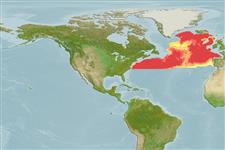Classification / Names
Nombres comunes | Sinónimos | Catalog of Fishes(Género, Especie) | ITIS | CoL | WoRMS | Cloffa
>
Scombriformes (Mackerels) >
Chiasmodontidae (Snaketooth fishes)
Etymology: Pseudoscopelus: Greek, pseudes = false + Greek, skopelos = a lantern fish (Ref. 45335). Lütken did not recognize the presence of photophores on the body, confusing them with pores, but referred to a genus of lanternfish (Scopelus now Myctophum) when he named the genus (Ref. 85782); astronesthidens: Named for the characteristic shape of the marginal premaxillary teeth, resembling the dentition in the stomiiform genus Astronesthes..
Environment: milieu / climate zone / depth range / distribution range
Ecología
marino batipelágico; rango de profundidad 1110 - 1250 m (Ref. 78617). Deep-water
North Atlantic: Endemic to the North Atlantic and has a central-oceanic type of distribution; Canada.
Tamaño / Peso / Age
Maturity: Lm ? range ? - ? cm
Max length : 15.0 cm SL macho / no sexado; (Ref. 78617)
Short description
Claves de identificación | Morfología | Morfometría
Espinas dorsales (total) : 7 - 8; Radios blandos dorsales (total) : 23 - 28; Radios blandos anales: 23 - 28; Vértebra: 36 - 37. This species is characterized by the following: dark orobranchial cavity; inclined teeth in the marginal row on the premaxillary are increased in size in the postorbital portion of the bone; teeth on the tongue; minute or no gill rakers on first gill arch; maxillary (suborbital) photophores usually well developed, disconnected with anteropreopercular photophores; well developed posteropreopercular photophores; no transverse ventral (interventral) photophores; thin cranial roofing bones; upper jaw long, 66.7-76.2% head length (HL), usually more than 69% HL (80% of specimens; mean 70.3%); moderately long pectorals, 16.0-22.5% SL, usually more than 17% SL (95% of specimens; mean 19.1%); group of three pores above the second nare; 36-37 vertebrae (Ref. 78617).
Life cycle and mating behavior
Maturities | Reproducción | Spawnings | Egg(s) | Fecundities | Larva
Prokofiev, A.M. and E.I. Kukuev, 2006. Two new species of linebellies (Genus Pseudoscopelus) with a revised key of species (Perciformes: Chiasmodontidae). J. Ichthyol 46 (Suppl. 1):21-37. (Ref. 78617)
IUCN Red List Status (Ref. 130435)
Human uses
Herramientas
Special reports
Download XML
Fuentes de Internet
Estimates based on models
Preferred temperature (Ref.
123201): 2.5 - 3.1, mean 2.8 °C (based on 1162 cells).
Phylogenetic diversity index (Ref.
82804): PD
50 = 0.5000 [Uniqueness, from 0.5 = low to 2.0 = high].
Bayesian length-weight: a=0.00389 (0.00180 - 0.00842), b=3.12 (2.94 - 3.30), in cm total length, based on all LWR estimates for this body shape (Ref.
93245).
Nivel trófico (Ref.
69278): 3.7 ±0.2 se; based on size and trophs of closest relatives
Fishing Vulnerability (Ref.
59153): Low vulnerability (10 of 100).
